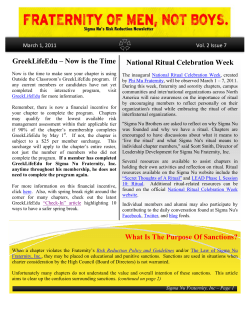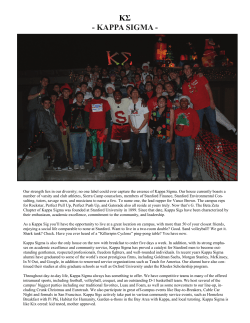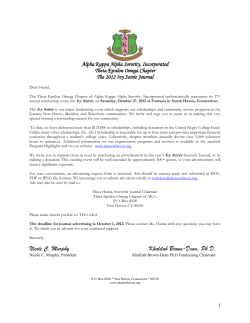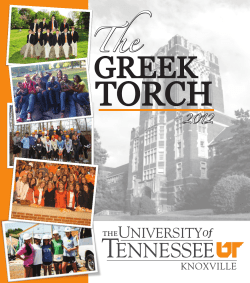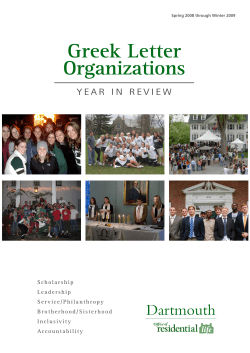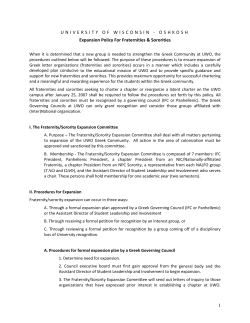
OUR MUTUAL QUEST… inter-fraternity history & objectives
OUR MUTUAL QUEST… inter-fraternity history & objectives Origin of Fraternities .............................................81 US Presidents in Fraternities …...…….…….…...83 Nomenclature .……………………………...…......84 Interfraternal Acronyms ...….…….……..………86 College Fraternities ...…....…….………….……...86 National Interfraternity Conference ...…….........88 Other Interfraternity Organizations ……………89 80 ORIGIN OF FRATERNITIES The American college fraternity system is as old as the United States itself, for it was in 1776 that the first secret Greek-letter society came into existence. It was the custom then for students at William and Mary, the second oldest college in America, to gather in the Apollo Room of the Raleigh Tavern in Williamsburg, Virginia, to discuss the affairs of the day. On the night of December 5, 1776, five close companions stayed after the others had left and founded Phi Beta Kappa. A secret motto, grip, and ritual were subsequently adopted. The Fraternity had to be secret because the William and Mary faculty did not approve of its students discussing social issues and possibly straying too far from accepted beliefs. Therefore, the members developed secret signals of challenge and recognition. The concept of a secret grip, motto, ritual, a distinctive badge, code of laws and the use of Greek letters by Phi Beta Kappa were adopted by subsequent fraternities. Fraternity, Morality, and Literature were the principles symbolized by the stars on the silver medal adopted as the insignia of Phi Beta Kappa membership. The society prospered, and three years later expansion began. Chapters were established at Yale, Harvard, Dartmouth and numerous other campuses. As Phi Beta Kappa developed, it evolved into a purely honorary society. For this reason, as other fraternities were founded, they were not considered competitors. By 1826, Phi Beta Kappa had become a scholarship society, much as it is known today. Beginning with Kappa Alpha Society, established at Union College, New York on November 26, 1825, the continuous existence of social fraternities began. This group is generally recognized as America’s oldest college social fraternity. Although many students and faculty members opposed Kappa Alpha Society due to its secrecy, other students admired the concept of the organization and formed Sigma Phi on March 4, 1827, and Delta Phi on November 17, 1827. Kappa Alpha Society, Sigma Phi, and Delta Phi formed the “Union Triad,” and set the pattern for the American fraternity system. Eventually, Union students founded six fraternities, which is why the college is recognized as the “Mother of Fraternities”. By 1860, the fraternity system was firmly established with 22 of the present-day general fraternities already having been founded. During the Civil War, Southern universities practically ceased to function with virtually all young men in the service. As a result, most fraternities suspended activities. In a few cases fraternity brothers attempted to remain organized within their military units. Theta Xi was the only fraternity organized during the Civil War and was also the first professional fraternity, centered on the engineering disciplines. Healing the wounds left by the bitter sectional feeling after the war was a task particularly suited to fraternities. Responding to the urgency of this situation was Alpha Tau Omega, the first fraternity founded after the Civil War in 1865; Kappa Alpha Order, 1865; Kappa Sigma Kappa, 1867; Pi Kappa Alpha, 1868; Sigma Nu, 1869; and Kappa Sigma, 1869; all in Virginia. 81 The nation and its campuses were not the same after the Civil War. One significant change was the increased entrance of women into higher education. “Aware of the condescending and frequently scornful activities of the male students,” writes one historian, women “wanted nothing more than to prove their capabilities and to achieve an equally important position” on their campuses. Sororities had their beginnings at Wesleyan Female College, Macon, Georgia. The Adelphean Society was organized May 15, 1851, and followed a year later by the Philomathean Society. They remained strictly local sororities for more than 50 years before adopting Greek names and expanding as Alpha Delta Pi and Phi Mu, respectively. I.C. Sorosis (now Pi Beta Phi) was founded April 28, 1867, at Monmouth College, Monmouth, Illinois as the first national sorority, and Kappa Alpha Theta was founded January 27, 1870, at DePauw University, Greencastle, Indiana, as the first women’s Greek-letter society. In the early days, most educational institutions existed primarily to prepare young men for the clergy or other professional careers. Emphasis was placed upon the classical studies, especially Greek and Latin. When fraternities evolved, it was natural for them to draw on those teachings. Literary exercises were a common part of all chapter meetings, where the presentation of essays and debates was customary. At first, meetings were held in rented rooms but soon the chapters acquired halls which they furnished as club rooms. As more and more men entered college, curricula expanded and many colleges became universities. The church relationship with schools weakened and, in many cases, ceased altogether. New institutions and state-supported institutions grew to fulfill the need for mass education. As the chapters grew larger, they found it possible and desirable to provide living quarters. Soon the fraternity house became a common site in college towns. Fraternities which lacked sufficient leadership soon passed out of existence. Those which were well-organized expanded at a rapid rate and encouraged the formation of new fraternities. The Greek system entered into the 20th Century with the realization of the importance of interfraternity endeavors. An intersorority conference (the forerunner of today’s National Panhellenic Conference) met in Chicago in 1902 and the National Interfraternity Conference first convened in New York City in 1909. World War I was fought to “make the world safe for democracy.” Following the war, rapid fraternity expansion characterized collegiate life in the 1920’s. The Great Depression caused many fraternities to disappear or merge in the 1930’s, and World War II found many more chapters temporarily closed - entire memberships were drafted or volunteered - and many of their houses used by the government for military housing. The end of the fraternity system was feared by some and predicted by many. With peace in 1945, men flocked to the campuses to resume their studies and to resume fraternity life as well. Matured by the war, they had a serious attitude toward studies, an impatience with juvenile hazing practices, and an openness to consider some social changes, they acknowledged and began to resolve discriminatory 82 inequities. The growth of the huge, impersonal education complex resulted in an increased need for fraternities and their personal contact and relationships within a smaller group. In the late 1960’s and early 1970’s students challenged all that was traditional. Fraternities, highly visible and identifiable, were considered to be part of the “establishment” and not germane to the era. The Greek system responded, after a period of difficulty, by reexamining itself, reaffirming principles and purposes, and realigning priorities and programs. Students responded by recognizing fraternities as a means for personal development and achievement. As colleges increased in number and enrollment, new fraternities were needed and many were established in the United States and Canada. Hundreds of local societies had sprung up and there were not enough national organizations to absorb them. This situation brought about the formation of more general fraternities. Fraternities have undergone many changes in organization since their inception. Originally, they consisted of independent chapters, loosely bound by common principles and a common name. Today they have become thoroughly organized national and, in some cases, international institutions. Most maintain full-time staff which operates out of headquarters offices. Today fraternities are expanding and most colleges and universities now permit national fraternities to organize on their campuses. There is constant improvement in the cooperation between fraternities and college administrations. Local interfraternity councils are becoming more effective, and most national fraternities are instituting programs that aid materially in the development of their members. More benefits are being derived from fraternity membership than ever before. We look forward to an era of continued growth and prosperity for the American college fraternity system, the world’s greatest youth movement. U.S. PRESIDENTS WHO ARE MEMBERS OF GENERAL FRATERNITIES James K. Polk Ulysses S. Grant Rutherford B. Hayes James A. Garfield Chester A. Arthur Grover Cleveland Benjamin Harrison William McKinley Theodore Roosevelt William Howard Taft Woodrow Wilson Calvin Coolidge Kappa Alpha Society Delta Phi Delta Kappa Epsilon Delta Upsilon Psi Upsilon Sigma Chi Phi Delta Theta & Delta Chi* Sigma Alpha Epsilon Alpha Delta Phi & Delta Kappa Epsilon* Acacia & Psi Upsilon* Phi Kappa Psi Phi Gamma Delta 83 Franklin D. Roosevelt Harry S. Truman Dwight D. Eisenhower John F. Kennedy Gerald R. Ford Ronald Reagan George H. W. Bush George W. Bush Alpha Delta Phi Lambda Chi Alpha Tau Epsilon Phi Phi Kappa Theta Delta Kappa Epsilon Tau Kappa Epsilon Delta Kappa Epsilon Delta Kappa Epsilon *Although no longer possible to belong to more than one general college fraternity, an individual in previous times could hold dual membership under certain circumstances. Former President Ronald W. Reagan addressed the National Interfraternity Conference 75th Anniversary Banquet with this filmed message: “Your organization and the college and university fraternities you represent have good reasons to be proud of your many achievements. We cannot reach confidently for the future without responsible leadership, educational achievement, and firm grasp on traditional values...” “By making sure that the fraternity system remains a positive influence on our college and university campuses, you’re helping America meet the great challenges that lie ahead.” President Reagan was presented the NIC’s Gold Medal at a 1984 White House luncheon. NOMENCLATURE The term nomenclature refers to the set of symbols by which an organization is named. The name of a fraternity is usually composed of two or three Greek letters (e.g., Theta Xi, Kappa Sigma Kappa). These letters commonly represent a motto which, in most instances, is unknown to all but members and which indicates, in a short form, the purpose and aims of the organization. The branches and groups located at the various colleges and universities are, with few exceptions, called chapters. Chapters receive individual names, sometimes from the Greek alphabet in order of their establishment (Alpha, Beta, Gamma, etc.) and sometimes without apparent order, in which case the chapter letter is generally the initial of some word peculiar to the college or a motto adopted by the chapter. Sometimes they are named for the host institution (Union Chapter) or for the college town (Middletown Chapter). Several fraternities have adopted the state system, naming the first chapter established in each state Alpha, and so forth (New YorkBeta, etc.). FRATERNITY LANGUAGE DON’T SAY “FRAT” - “Frat” is an abbreviation which is simply not appropriate. It is generally used as an expression of contempt when used with regard to high school and non-collegiate societies. It should never appear in the vocabulary of a college fraternity man. When speaking about a college fraternity, say “fraternity”. 84 WHEN TO USE ALUMNUS AND ALUMNI - An alumnus is a male graduate, or former student. Alumni is the plural of alumnus. The feminine form is alumna (singular) and alumnae (plural). Great care and precision should be employed by fraternity men in using these terms appropriately. GENERAL FRATERNITY - A General Fraternity is one which does not appeal to a special interest group. Theta Xi may be properly described as a General Fraternity. FRATERNITY CORRESPONDENCE — When one Brother writes to another, the correct salutation is “Dear Brother”. Brother should never be abbreviated “Bro”. The accepted closing for a letter between two initiated members is “Yours in the Bonds," or for informal correspondence, "YITB." When one or both correspondents is/are associate member(s), the proper closing is “Fraternally”. The proper closing for correspondence between members of different fraternities is either “Fraternally” or “Interfraternally”. ASSOCIATE MEMBER - An associate member is a prospective member of your chapter who has taken the vows required in the formal Associate Member (pinning) Ceremony. INITIATE - An initiate is an initiated member, one who has received the Ceremony of Initiation. UNDERGRADUATES - Members of the present collegiate chapter are called undergraduates or "undergraduate members." GRADUATES - Members of the chapter or any chapter who have graduated or left college are known as graduate members or alumni. CHAPTER - A chapter is an organization, a house is the chapter’s residence. It is incorrect to call the chapter (organization) a house. INITIATION - The preferred term used to describe the Fraternity’s ritual ceremony of induction of associate members into chapter membership. DON'T SAY NATIONAL(S) - The Fraternity is made up of all members. When talking about the "National" be sure to clarify whom you are talking about. Is it Headquarters Staff, Grand Lodge, the National Convention? If so, use their proper designation. "National(s)" if it means anything, referrers to all members. By the way, national is singular, not plural and is an adjective, not a noun. On a side note, a national fraternity should not be confused with an international fraternity. A national fraternity is one that has chapters within the United States. An 85 international fraternity is one that has chapters both in Canada and in the United States. INTERFRATERNAL ACRONYMS IFC Interfraternity Council NIC North-American Interfraternity Conference NPC National Panhellenic Conference NPHC National Pan-Hellenic Council FEA Fraternity Executives Association FIPG founded as Fraternity Insurance Purchasing Group, now FIPG, Inc. AFA Association of Fraternity Advisors NASPA National Association of Student Personnel Administrators NALFO National Association of Latino Fraternal Organizations NMGC National Multicultural Greek Council COLLEGE FRATERNITIES Founding Year 1824 1825 1827 Fraternity Founding Chapter Location 1850 1852 1855 Chi Phi Kappa Alpha Society Delta Phi Sigma Phi Alpha Delta Phi Psi Upsilon Delta Upsilon Beta Theta Pi Chi Psi Delta Kappa Epsilon Alpha Sigma Phi Delta Psi Theta Delta Chi Phi Delta Theta Phi Gamma Delta Phi Kappa Sigma Phi Kappa Psi Sigma Chi Princeton Union Union Union Hamilton Union Williams Miami-Ohio Union Yale Yale Columbia Union Miami-Ohio Washington & Jefferson Pennsylvania Washington & Jefferson Miami-Ohio 1856 Sigma Alpha Epsilon University of Alabama 1832 1833 1834 1839 1841 1844 1845 1847 1848 86 1858 Theta Chi Delta Tau Delta Norwich Bethany 1864 THETA XI Rensselaer 1865 1868 1869 1873 1889 1890 1895 1897 1898 1899 1900 1901 1904 1905 1906 1907 1909 1910 1911 1913 1914 1918 1920 1923 1924 1925 1928 1931 1932 1943 Alpha Tau Omega Kappa Alpha Order Pi Kappa Alpha Kappa Sigma Sigma Nu Phi Sigma Kappa Phi Kappa Theta Delta Chi Alpha Chi Rho Delta Sigma Phi Pi Lambda Phi Sigma Pi Zeta Beta Tau Tau Kappa Epsilon Kappa Delta Phi Sigma Phi Epsilon Acacia Alpha Gamma Rho Pi Kappa Phi Farmhouse Kappa Delta Rho Alpha Phi Alpha Phi Kappa Tau Triangle Lambda Chi Alpha Sigma Alpha Mu Tau Epsilon Phi Kappa Alpha Psi Omega Psi Phi Alpha Epsilon Pi Alpha Kappa Lambda Phi Beta Sigma Alpha Phi Delta Phi Mu Delta Sigma Tau Gamma Alpha Gamma Sigma Alpha Delta Gamma Sigma Phi Delta Beta Sigma Psi Phi Lambda Chi Tau Delta Phi Phi Iota Alpha Alpha Delta Phi Sigma Beta Kappa 87 VMI Washington & Lee University of Virginia University of Virginia VMI U of Massachusetts Brown Cornell Trinity C.U.N.Y. Yale Vincennes New York City Illinois Wesleyan U. Bridgewater State College U. of Richmond Michigan Ohio State U. University of Charleston (SC) Missouri Middleburg Cornell Miami-Ohio University of Illinois Boston University CUNY Columbia Indiana University Howard University NYU Cal Berkeley Howard University Syracuse University University of Connecticut Cent. Missouri State University of Missouri Loyola-Chicago University of Southern California University of Illinois Arkansas STC City College of New York Rensselaer Hamilton College St. Bernard's-Alabama 1963 1967 1975 1979 1981 1986 1987 1988 1994 1996 1999 Iota Phi Theta Sigma Gamma Chi Lambda Theta Phi Lambda Sigma Upsilon Lambda Phi Epsilon Sigma Lambda Beta Omega Delta Phi Phi Sigma Phi Iota Nu Delta Sigma Beta Rho Beta Chi Theta Morgan State University University of Utah Kean College Rutgers UCLA University of Iowa Texas Tech Southbend, Indiana Binghamton University S.U.N.Y. Binghamton UCLA INTERFRATERNITY ORGANIZATIONS NORTH-AMERICAN INTERFRATERNITY CONFERENCE The National Interfraternity Conference (NIC), an association of men’s general national and international college fraternities, was founded in New York City on November 27, 1909. Several efforts to coordinate the activities of men’s fraternities had taken place earlier, but the meeting called in New York by Dr. W.H.P. Faunce, president of Brown University, finally achieved the formation of a national association. Theta Xi is a senior member of the Conference, having been admitted to membership in 1911. Subsequently, the Conference changed its name to the NorthAmerican Interfraternity Conference to better reflect its membership. Annual meetings of the NIC are held in April, with additional meetings held, as needed, in early December. Each member fraternity is represented by one delegate and one alternate. The conference provides a forum for the discussion of fraternity concerns and is a reservoir of informed opinion regarding fraternity operations and policies. It is a vehicle for joint action in protecting and promoting fraternity interests, and is an important instrument for developing cooperation among fraternities and their host institutions. The Conference regularly publishes minutes of general meetings and meetings of its Board of Directors. In 1934 the Conference adopted the “Fraternity Criteria”, which was revised in 1981. These criteria represent the NIC’s declaration of principles and its method of providing for closer cooperation between fraternities and educational institutions. To accomplish this goal, all member organizations abide by a common, agreed upon, set of standards. Two members of Theta Xi have served as President of the NIC. William J. Barnes, Gamma 318, was President in 1950; and Zeke L. Loflin, Alpha Alpha 112, held the office in 1969. 88 OTHER INTERFRATERNITY ORGANIZATIONS Two additional interfraternity groups work in close cooperation with the NIC. The oldest is the College Fraternity Editors Association (CFEA), which first met in 1883, and was officially recognized in 1923. Harold P. Davison of Theta Xi served as CFEA Chairman in 1950-51. The second group is the Fraternity Executives Association (FEA), which was founded in 1930. Brother Davison served as President of FEA in 1948-49 and Brother James E. Vredenburgh, Jr. served as President in 1993-94. The goals of the NIC are met on campus by local interfraternity councils. It is traditional for Theta Xi men to make their talents available to their local interfraternity systems. We are partners with every fraternity. Just as our brotherhood is larger than any one Brother, interfraternity brotherhood is larger than the individual Fraternity within the NIC. 89
© Copyright 2025






